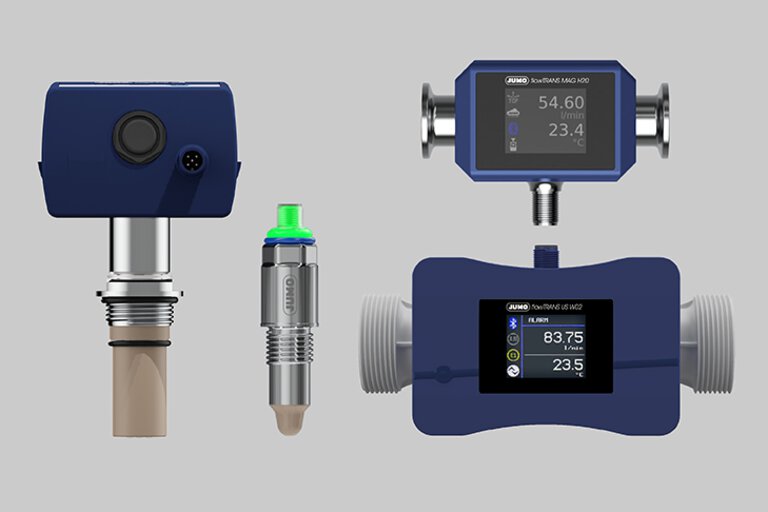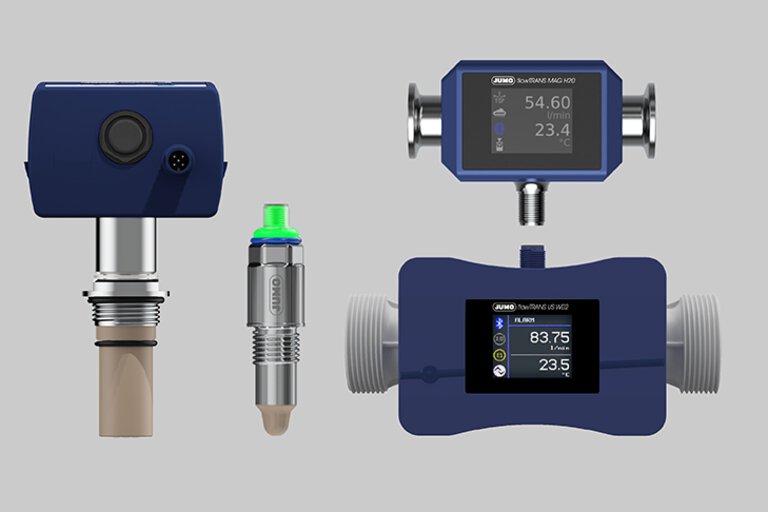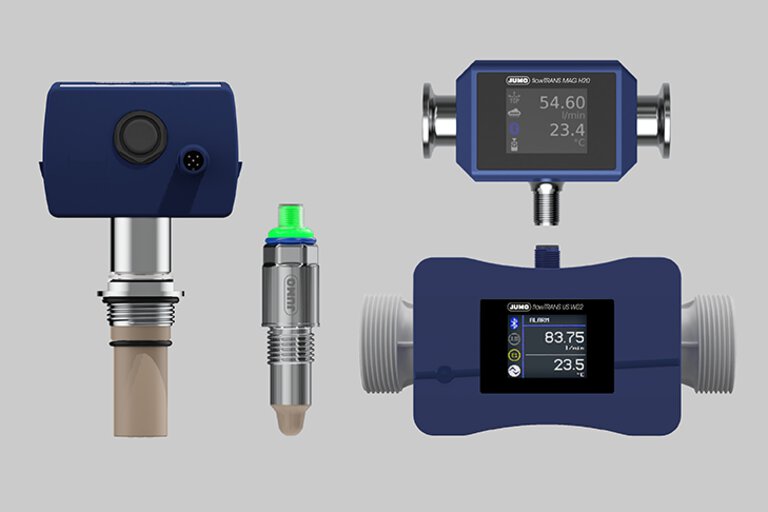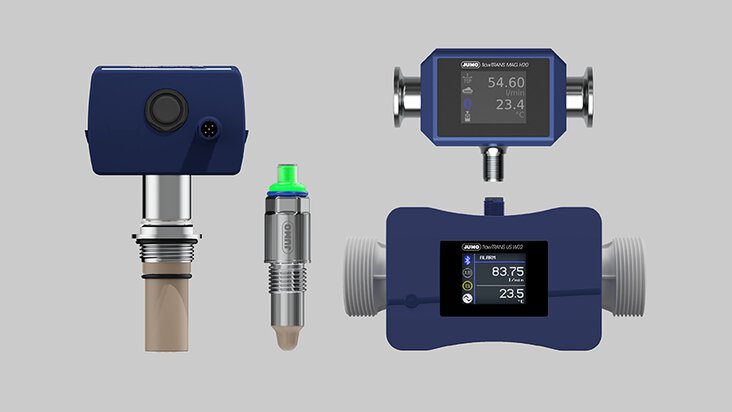
IO-Link – the key facts at a glance
Reliable, fast, and efficient sensor communication is essential modern industrial automation. As a pioneer of Industry 4.0 applications, IO-Link ensures seamless communication down to the lowest field level, thereby enabling easy integration of sensors and actuators into modern automation environments. This article explains the most important aspects of IO-Link and the associated advantages for industrial processes.
Table of contents
What is IO-Link?
IO-Link is the first globally standardized interface for fieldbus-independent communication between sensors/actuators and the control level of an automation system. The technology enables bidirectional data transmission. It also simplifies the diagnosis and parameterization of connected devices.
How does IO-Link work?
IO-Link communication always takes place between 2 end points, namely an IO-Link Master and an IO-Link device (sensor/actuator). Data transmission between master and device takes place via standardized and cost-effective 3-wire or 5-wire cables. Digital data transmission eliminates the typical problems of analog transmission (signal loss, electromagnetic interference, inaccuracy, etc.). The IO-Link Master is the link to a higher-level automation system or a control unit (PLC). Communication typically takes place via Industrial Ethernet (PROFINET, Ethernet/IP, Modbus TCP, etc.).
Which components are required for an IO-Link system?
An IO-Link system always consists of several components. These include:
- IO-Link devices (sensors/actuators)
- IO-Link Master
- Connecting cables for sensors and actuators (3-wire/5-wire, unshielded)
- Network/voltage line
- Engineering tool for project planning and parameterization
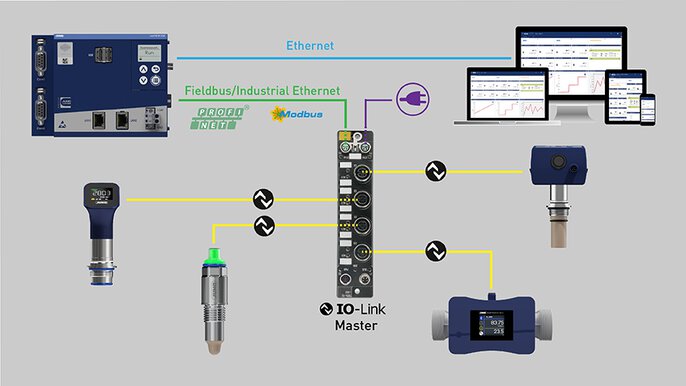
Typical IO-Link architecture
IO-Link devices
IO-Link devices (or IO devices) include sensors, actuators, or RFID readers that communicate directly with an IO-Link Master via the IO-Link protocol. Their great advantage lies in their ability to transmit process data as well as service and diagnostic data such as operating states or error messages.
IO-Link Master
The IO-Link Master is a central component in an IO-Link system and serves as a link between IO-Link devices (field level) and a control unit (control level). It provides several IO-Link ports (typically 4 or 8) for connecting the devices, collects the data from the connected devices, and forwards them in a bundle to the higher-level control unit. It supplies the devices with voltage, manages them, and takes over the configuration as well as the diagnosis of the devices.
Also, it offers various error detection functions and makes it easier to integrate existing IT systems, which significantly increases the efficiency and flexibility of automation solutions (particularly in the context of Industry 4.0).Typically, a master has an integrated web server so that remote access is possible and all functions can be utilized directly over the network.
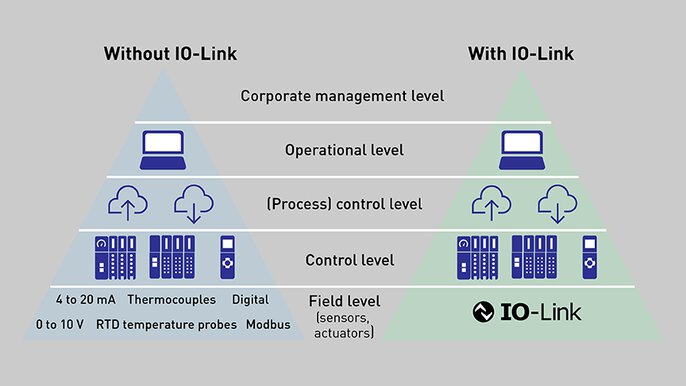
Automation pyramid with and without IO-Link
What is IO-Link Safety?
IO-Link Safety is an extension of the IO-Link technology that has been developed specifically for safety-critical applications in industrial environments. It enables the integration of safety functions into the IO-Link architecture. Furthermore, it extends the existing IO-Link standard to include safety-related communication between sensors or actuators and a safety controller.
What is IO-Link Wireless?
Similar to IO-Link Safety, IO-Link Wireless is also an extension of conventional IO-Link communication that enables sensors and actuators to be connected wirelessly to control systems. This means that IO-Link communication can be carried out wirelessly without physical cabling, thereby improving installation, flexibility, and scalability in industrial environments. IO-Link Wireless is often used for system components that are difficult to access or move as well as for expensive and complicated installations.
What are IODDs?
The abbreviation IODD stands for IO Device Description. This is a file that describes the features of an IO-Link device. It contains important information such as the device type, the manufacturer ID, the communication parameters, and details of the device's functionalities. IODDs enable the IO-Link Master and the higher-level systems to automatically recognize the connected devices and configure them correctly.
What is the IEC 61131-9 standard?
The IEC 61131-9 standard is an international standard that was developed specifically for communication between controllers and devices in industrial automation systems. It defines the technical specifications for "Single-Drop Digital Communication Interfaces (SDCI)", commonly known as IO-Link.
What advantages does IO-Link offer in industrial communication?
IO-Link architectures offer numerous benefits which range from the optimization of production processes to the reduction of maintenance costs:
Optimization of the production process due to communication down to the lowest field level
Flexibility, production performance, and remote maintenance are important performance parameters for machines and plants. Sensors with IO-Link now give the plant operator access to the lowest field level. Only minimal effort is required to retrieve sensor information, configuration parameters, and diagnostic data for optimal evaluation of plant conditions.
Reduction of mounting and startup times
The use of IO-Link can significantly reduce the required effort for mounting and startup. This is made possible by the simplified cabling and the option to automate startup by maintaining and duplicating parameters.
During mounting, ready-to-install cables are used so that no assembly is required and error sources are omitted. Startup is also possible through automation as the parameters can be downloaded and made available to the device in a matter of seconds.
Due to the fieldbus independence, the inventory diversity is considerably reduced and each sensor always has its "ID card" in the form of the IODD.
Increase in plant efficiency through maximum transparency down to the sensor level
Times when plants are unexpectedly at a standstill due to a faulty sensor are a thing of the past with modern IO-Link systems. After all, the functions included in the sensors (such as operating hours counters, drag indicators, and error and short-circuit detection) help to identify and rectify critical sensor conditions at an early stage, thereby significantly increasing plant efficiency.
IO-Link offers the option of exchanging cyclical as well as acyclic data with superordinate levels. For example, parameter data can be loaded into a sensor or diagnostic data can be extracted during operation. The data is exchanged quickly and is available in seconds thanks to a COM3 transfer speed of 230.4 kbaud and cycle times of less than 1 ms in some cases.
Reliable sensor identification through IO-Link device ID & IODD
The device ID is a unique identifier assigned by the manufacturer for each IO-Link device. It enables the master to clearly identify the connected device and to assign the appropriate device description (IODD – IO Device Description).
As soon as the IODD has been imported into the master, the master recognizes all the features of the device. For a sensor, these can be features such as sensor type (temperature sensor, pressure sensor, etc.), measuring range, or accuracy class. The IODD also contains various information about the device manufacturer such as the manufacturer's name, the manufacturer's logo, or the manufacturer's URL. When a sensor is connected to a master port, the device IDs are synchronized.
If the device ID of the sensor does not match the IODD that is stored for this port, an error is immediately detected and reported. As a result, any swapping of sensors with different measuring ranges or accuracy classes, for example, can be detected immediately. The "wrong" sensor can be replaced directly after installation, rather than during operation, which reduces downtime.
How fast is IO-Link?
A total of 3 different transmission speeds are available. These are designated COM1, COM2, and COM3:
- COM1: 4.8 kbaud
- COM2: 38.4 kbaud
- COM3: 230.4 kbaud (fastest)
Each IO-Link device can handle 1 of the 3 transfer rates and, as a result, defines the communication speed for the respective port. Consequently, 1 IO-Link master can handle all 3 transfer rates.
What is an IO-Link profile?
An IO-Link profile is a standardized collection of functions and parameters defined for specific device types or applications. These profiles simplify the integration and exchange of IO-Link devices, as they use the same functions and data formats regardless of the manufacturer. The following profiles are currently available:
Common Profile
The Common Profile provides a basis for the standardization of certain functions across different device types. It defines fundamental parameters and functions that are relevant for many IO-Link devices, regardless of their specific area of application. This makes integrating and managing devices from different manufacturers within an IO-Link system easier.
Smart Sensor Profile
The Smart Sensor Profile is specifically designed for intelligent sensors and includes advanced features that go beyond the basic functions of a simple sensor. These may include extended diagnostic data, condition monitoring functions, and the ability to perform self-configuration. This profile enables sensors not only to collect data, but also to process as well as communicate information about their own condition and performance, which can be crucial for servicing (predictive maintenance).
Firmware Update Profile
The firmware update profile defines a standardized process for updating the firmware of IO-Link devices via the IO-Link connection. This profile is particularly important as it enables the maintenance and update of devices in the field without the need for physical access or replacement of the devices. This means that updates can be carried out more quickly and cost-effectively.
The IO-Link Community is already working on further profiles that will continue to increase the functional range and user benefits. Examples include the Smart Actuator Profile, the Lighting and Indication Profile, and the Smart Power Systems Profile.
What is the IO-Link Community?
The IO-Link Community is an organization dedicated to the further development, standardization, and distribution of IO-Link technology. It was established as part of the PROFIBUS User Organization (PNO), which in turn is one of the largest communities for industrial communication worldwide. This community is composed of a large number of manufacturers, developers, system integrators, and users who work in the fields of automation technology and industrial production.
What does the future hold for IO-Link?
As the technology continues to be developed and improved, more and more companies are recognizing the advantages of IO-Link. In 2023, more than 35 million IO-Link devices had already been installed, which is 8.4 million more than in the previous year. One reason is the ongoing development of Industry 4.0 applications and the Industrial Internet of Things (IIoT), for which IO-Link is ideally suited.

IO-Link nodes at a glance
Are challenges associated with implementing IO-Link?
Although IO-Link offers numerous advantages, implementation can pose challenges, particularly in terms of staff training and integration into existing systems. The need for comprehensive planning and possibly also for adaptation of existing infrastructure may result in initial costs, but these are justified by the long-term reductions and increases in efficiency. The support of an expert is definitely worthwhile to ensure smooth and efficient integration into existing systems.
- ${title}${badge}
